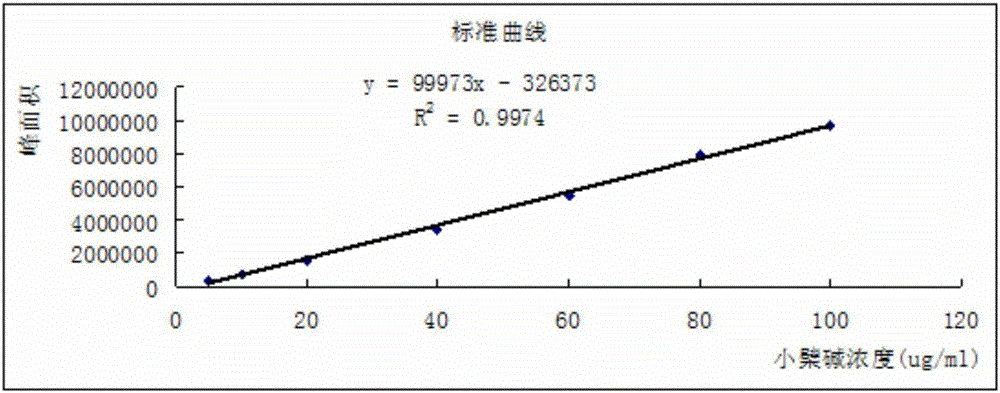Production technology for extracting berberine from cortex phellodendri and coptidis rhizoma through complex enzyme method
A production process and compound enzyme technology, which is applied in the fields of traditional Chinese medicine pharmaceuticals, veterinary drugs, feed or raw material processing, and pesticides, can solve problems such as easy pollution, and achieve the effects of low cost, simple operation, and simple process
- Summary
- Abstract
- Description
- Claims
- Application Information
AI Technical Summary
Problems solved by technology
Method used
Image
Examples
Embodiment 1
[0050] Combined with the properties of β-glucanase, xylanase, phytase, and cutinase, three factors are selected, namely enzymolysis temperature, enzymolysis pH, and enzyme addition (the ratio of medicinal materials to enzymes). A three-level three-factor orthogonal table was designed, and the value ranges of the three factors were: enzymatic hydrolysis temperature (30°C, 40°C, 50°C); enzymatic hydrolysis pH (3.0, 4.5, 6.0); enzyme ratio (herb: β- Glucanase: xylanase: phytase: cutinase = 500: 2-6: 0.1-0.5: 0.5-1: 2-6), orthogonal table 2-3.
[0051] Table 2 Enzyme hydrolysis factor level table
[0052]
[0053] Table 3 Orthogonal experiment table
[0054]
[0055] (1) Crush Cortex Phellodendri (Coptis Rhizoma) until it becomes granular, and pass through a 20-mesh sieve.
[0056] (2) Weigh 200g of pulverized Chinese medicinal materials, add various enzymes according to the conditions designed by the orthogonal experiment, add water and soak for 60 minutes, adjust the pH ...
Embodiment 2
[0066] According to the best result of embodiment 1 test, enzymolysis temperature: 50 ℃; Enzymolysis pH value: 6.0, add enzyme ratio (cork cork: β-glucanase: xylanase: phytase: cutinase=500 :4:0.25:0.5:4).
[0067] (1) Weigh 200g of Phellodendron cortex, crush it, pass through a 20-mesh sieve, add 400g of water and soak for 60min, add 1.6g, 0.1g, and 0.2g of β-glucanase, xylanase, phytase, and cutinase to it , 1.6g, hydrochloric acid solution to adjust the pH to 6.0, enzymolysis at 50°C for 6h, and boiling for 4min to inactivate the enzyme.
[0068] (2) Add 1400g of water, adjust the pH to 2.5 with dilute hydrochloric acid, extract at 90°C for 70 minutes, filter while hot, and collect the filtrate.
[0069] (3) Add 1500 mL of 70% ethanol to the filter residue, extract at a temperature of 90° C. for 90 min, extract twice, concentrate the filtrate, and adjust the pH to 3 with hydrochloric acid;
[0070] (4) Add saturated NaCl solution, stir until a yellow product flocs out, fi...
Embodiment 3
[0075] (1) Weigh 200g of Cortex Phellodendri, crush it, pass through a 20-mesh sieve, soak in water for 60min, add β-glucanase, xylanase, phytase, cutinase each 1.6g, 0.1g, 0.2g, 1.6g, adjust the pH to 6.0 with hydrochloric acid solution, enzymatically hydrolyze at 50°C for 3h, and boil for 4min to inactivate the enzyme.
[0076] (2) Add 1320g of water, adjust the pH to 3 with dilute hydrochloric acid, extract at 90°C for 70 minutes, filter while hot, and collect the filtrate.
[0077] (3) Add 1600 mL of 70% ethanol to the filter residue, extract at 75°C for 60 min, extract twice, concentrate the filtrate, and adjust the pH to 3 with hydrochloric acid;
[0078] (4) Add saturated NaCl solution, stir until a yellow product flocs out, filter with suction, dry, store overnight at 4°C, filter with suction, and dry to obtain the final product.
[0079] (5) Weigh the product weight after drying and cooling, calculate the yield, yield=(product quality / medicine quality)×100%, measure ...
PUM
 Login to View More
Login to View More Abstract
Description
Claims
Application Information
 Login to View More
Login to View More - R&D
- Intellectual Property
- Life Sciences
- Materials
- Tech Scout
- Unparalleled Data Quality
- Higher Quality Content
- 60% Fewer Hallucinations
Browse by: Latest US Patents, China's latest patents, Technical Efficacy Thesaurus, Application Domain, Technology Topic, Popular Technical Reports.
© 2025 PatSnap. All rights reserved.Legal|Privacy policy|Modern Slavery Act Transparency Statement|Sitemap|About US| Contact US: help@patsnap.com



